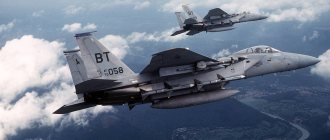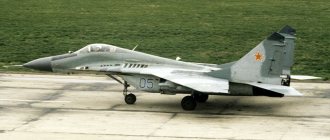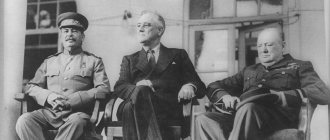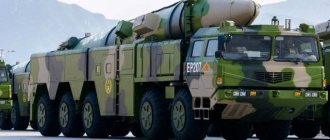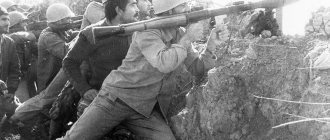The Russian S-400 Triumph long- and medium-range anti-aircraft missile system is designed to destroy missiles and aircraft, it can also be used against ground targets. The air defense system can hit targets at an altitude of up to 30 kilometers and a distance of up to 400 kilometers. The S-400 entered service on April 28, 2007. The first division, equipped with an air defense system, went on combat duty on August 6, 2007 in the city of Elektrostal, Moscow Region. The Triumph system was deployed in Syria at the Russian Khmeimim airbase in Latakia in November 2015.
How does the S-400 Triumph anti-aircraft missile system work? Infographics Read more
Who has already bought the S-400 from Russia?
China became the first export operator of Russian S-400 air defense systems. A contract worth more than $3 billion was signed in 2014, according to which the PRC should receive two regimental sets of the system. The first batch of air defense systems was sent to the customer in January 2018, and in July the S-400 entered service with the Chinese army.
In addition, two S-400 anti-aircraft missile systems are in service with Belarus. They were donated by Russia in 2016 as gratitude for the free lease of land in Baranovichi, where a Russian missile attack warning radar station was installed.
China became the first buyer of the S-400 Triumph air defense system
Back in September 2014, the Chinese authorities concluded a contract with the Russian Federation for the purchase of 4 divisions of S-400 Triumph anti-aircraft missile systems (ZRS), Rosoboronexport CEO Anatoly Isaikin told reporters about this in mid-April 2015. However, he did not disclose the details of the contract, noting only that China indeed became the first buyer of this newest domestic air defense system. According to Isaikin, the conclusion of this contract should emphasize the strategic level of relations between Russia and China.
Anatoly Isaikin emphasized that today many countries would like to buy the S-400. However, Russian industry, represented by VKO Almaz-Antey, primarily works with orders from the Russian Ministry of Defense, and the complexes are actively entering service with the Russian army. According to the head of Rosoboronexport, even taking into account the expansion of existing production capacities, it will be difficult to transfer the S-400 Triumph to several states at once. In this regard, China became the first sign, he emphasized.
The amount that Beijing will pay for the supply of 4 S-400 divisions has not been disclosed. But now we can confidently assume that we are talking about at least two billion dollars. According to estimates by the American portal Strategy Page, one division of Triumphs in the foreign market will cost buyers $500 million. This is provided that each delivery set includes 8 launchers, a command vehicle, a radar station and launch-loading installations.
It is worth noting that China has quite significantly reduced military exports of arms from Russia in recent years; they have learned to do a lot on their own. But in the field of air defense systems, the Chinese continued to rely on Russian-made military equipment. The last major contract with China for the supply of air defense systems was completed in 2010, when the transfer to China of 15 divisions of the S-300 PMU-2 air defense system, as well as four 83M6E2 control systems, was completed. The air defense systems transferred to China were included in the air defense systems of Beijing, Shanghai and some other cities of the Middle Kingdom.
At the same time, China wanted to purchase the S-400 Triumph when this complex was just put on production line in Russia. Negotiations with Rosoboronexport began back in 2012. Moreover, judging by the information available in the public domain, the talk was initially about supplying 6 S-400 divisions to China. But even then, supply negotiations were very difficult. Firstly, the Chinese were not happy that Russia was not ready to begin delivering the systems before 2022. The primary task was to equip the Russian army with new air defense systems, and even the hastily opened factories in St. Petersburg, Nizhny Novgorod and Kirov, it seems, did not allow the start of deliveries to China earlier. Secondly, Moscow has rightly and long feared that its Chinese partners need the latest S-400 air defense system not so much to urgently strengthen the defense of their own airspace, but rather for a banal engineering study and subsequent copying of Russian weapons. In order to then pass off the resulting copy as a product of the Chinese military-industrial complex and begin dumping trade in the international arena. It is worth noting that China has done this many times.
Problems with possible copying of the S-400 by China
According to Simon Wezeman, an expert on weapons and military spending at the Stockholm International Peace Research Institute, the Russian government is aware of the fact that Beijing is likely to copy the technologies used in the S-400. This has already happened with the S-300 air defense system, as well as other types of military equipment from Russia, which have been supplied to China over the past two decades, notes Simon Wezeman.
At one time, the first modern air defense system in service with the Chinese army was the Russian S-300, which Russia began exporting in the mid-1990s. Using the technologies of the Russian complex, China subsequently created its own long-range air defense system, designated HQ-9 “Red Flag”. “At that moment, it seemed that Beijing had enough strength to create more advanced air defense systems based on the acquired technologies. However, interest in acquiring the S-400 signals that China is not yet able to do this and, at least in the short term, will be dependent on foreign technologies, in this case Russian,” notes Wezeman.
It is worth noting that in recent decades, the PRC has presented Russia with many examples of copying weapons. For example, the new Chinese BMP ZBD04 is very similar to the Russian BMP-3. The Chinese MLRS PHL-03 is exactly reminiscent of the Russian MLRS Smerch. And the J-11 fighter cannot even be distinguished externally from the domestic Su-27SK. The same can be said about the J-15 carrier-based fighter, which is very reminiscent of our Su-33. The list goes on and on. What such copying can lead to was shown in 2013, when Russia lost the tender for the supply of 12 divisions of long-range air defense systems, announced by the Secretariat of the Turkish Defense Industry. The total amount of the transaction was $4 billion. An amount that is significant for any state in the world. For this reason, the United States submitted its Patriot PAC-3 to the competition, Russia its S-300, the Europeans its SAMP/T Aster 30, and China its HQ-9. The latter, which, in fact, is an unlicensed copy of the Russian S-300PMU-1, was able to win the Turkish competition, although it is inferior in characteristics to its Russian counterpart. The lowest price had its say, and this became the decisive factor for Ankara. In addition, the PRC proposed to localize 10% of the production of the complexes in Turkey itself, and a large arms contract sailed to Beijing.
It is clear that Russia justifiably pins special hopes on the international long-range air defense missile system with the S-400 Triumph air defense system, which currently has no analogues in the world. Even after 2022, when Russian units will be saturated with the new air defense system, and production capacity will be freed up for production for export. At that moment, it would be very sad to know that on this virtual counter there would also be something similar offered by China. As practice has shown, fighting Chinese piracy in the legal field is apparently useless.
RIA Novosti infographics
At the very least, all previous attempts by Russia to call on the Chinese to at least some kind of order were unsuccessful. The thing is that the eastern trick on the part of Chinese engineers is that when copying, they necessarily add some of their own modifications and improvements to the original product. After this, referring to the revision carried out, they declare the copy their “know-how”. Why did Moscow, understanding this perfectly well, still decide to make a deal? There can be two answers to this question. The first of them lies on the surface. Russia, which currently lives under a harsh regime of international sanctions, needs an influx of foreign currency. In the current crisis, it is not appropriate to throw away two billion dollars. But this reason is still not the main one. The main thing, according to Sergei Ishchenko from Free Press, is not finance, but politics.
At one time, the deal with the Mistrals apparently became political. The then French President Nicolas Sarkozy advocated a conciliatory position in Russia's short-lived armed conflict with Georgia in August 2008. At that moment, Sarkazy helped Moscow get out of the situation with the least reputational, financial and political losses for it. In turn, Russia could help the French president by loading the French military-industrial complex with a substantial order. At least, this version of the development of events seems convincing, given the fact that since then neither the political nor the military Russian leadership has given any clear comments on the topic of why Russia needed these landing ships.
Returning to the PRC, it can be noted that the political leadership in Beijing from the very beginning rejected the very idea of political and economic isolation of Moscow in connection with the tragic events that unfolded in Ukraine. Even on the situation with the return of the Crimean peninsula, China spoke out quite openly and with a straightforwardness unusual for Chinese politicians. Director of the Department of Europe and Central Asia of the Chinese Foreign Ministry Gui Cunyun said: “China is against any nation gaining independence through a referendum. If we talk about Crimea, then it has its own characteristics. We know very well the history of Crimea.”
RIA Novosti infographics
This was followed by a statement by Zhou Li, deputy head of the Department of International Relations of the CPC Central Committee, who Fr. In the current environment, such support at the international level is expensive. Perhaps even the S-400 Triumph can be risked. After all, Russia has a more promising system on the way - the powerful S-500 Prometheus anti-aircraft missile system.
S-400 will cover priority targets in China
According to Simon Wezeman, first of all, the S-400 systems acquired from Russia will be located at priority facilities in the PRC, which include the key military and administrative centers of the country, which are currently protected by the Russian S-300 air defense systems and Chinese HQ -9. The S-400 is effective in repelling attacks from cruise and operational-tactical missiles, which pose the main threat to such centers, the expert believes.
“These complexes are able to guarantee the destruction of a variety of targets - from the enemy’s cruise missiles to its strategic bombers, including those built using stealth technology,” says Igor Korotchenko, editor-in-chief of the National Defense magazine. “I believe that there are two main areas for using the S-400 Triumph: they will cover Beijing, as the largest political center in the country, as well as one of the coastal areas. The PRC, purchasing S-400 systems from Russia, is making a good investment in ensuring its national security,” noted Igor Korotchenko. Earlier, information appeared in the Chinese press that new Russian air defense systems could be used to cover the country's airspace in potentially dangerous directions from Japan, Vietnam, South Korea and Taiwan.
RIA Novosti infographics
According to Vasily Kashin, an expert at the Center for Analysis of Strategies and Technologies (Russia), China will be supplied not with the basic configuration for the Russian army, but with “heavy” missiles with a firing range of up to 400 km. These missiles will allow China to shoot down air targets over the East China Sea. “These missiles will make it possible to hit air targets in the Diaoyu Islands from the Chinese mainland,” explained Vasily Kashin.
In turn, Simon Wezeman believes that the increased firing range of the S-400 missiles will allow China to cover the Taiwan Strait and part of the airspace over the island itself. “Thus, China will gain an advantage in possible armed conflicts in the Taiwan area, as well as in parts of the South China and East China Seas,” Wezeman noted. According to a foreign military expert, such an air defense system in the hands of China is capable of changing the balance of power in the region, although such a change will not be dramatic.
Simon Wezeman believes that other states in the region will try to find ways to neutralize the advantages of the S-400, just as they did previously after Beijing purchased modern weapons systems. For example, with the help of long-range missiles with an anti-radar system, electronic warfare equipment and the latest aircraft made using stealth technology.
The S-400 complex in service with the Russian army
The S-400 anti-aircraft missile system was created by the Russian air defense concern Almaz-Antey on the basis of their other long-range air defense system, the S-300. China was also one of the main foreign buyers of the previous complex. In total, the People's Liberation Army of the People's Republic of China acquired 15 S-300 divisions, the contract was completed in 2010. Now Beijing has decided to once again rely on Russian weapons, this time on the S-400.
It is worth noting that the saturation of the Russian armed forces with this complex is currently in full swing. The last regiment equipped with the S-400 air defense system was deployed to Kamchatka. In April 2015, sea transport with 40 units of equipment from the regimental set of this air defense system arrived at the port of Petropavlovsk-Kamchatsky. The complexes will be deployed at duty positions near the cities of Petropavlovsk-Kamchatsky and Vilyuchinsk. They must replace the S-300 air defense systems on combat duty.
The modern S-400 air defense system is truly unique. It can confidently destroy not only enemy aircraft, but also cruise and operational-tactical missiles at a distance of up to several hundred kilometers. During tests of the S-400 at the Ashuluk and Kapustin Yar test sites, the crews of the complex managed to shoot down a target with one missile that was moving at a speed of 2800 m/s, and with another missile they hit a target that was at an altitude of 56 km.
The S-400 complex allows you to simultaneously fire at up to 36 air targets, aiming up to 72 missiles at them. In the west, the complex received the designation SA-21 Growler (“Growler”). A wide range of missiles can be used with this air defense system, including those from previous systems. Three of them - missiles 48N6E, 48N6E2 and 48N6E3 - are suitable for live firing with both the S-400 and the S-300PM version. The 48N6DM missile was created specifically for the S-400 Typhoon. These missiles are controlled according to the principle of semi-active radar homing with correction. Also, the Russian industry is preparing to release two more missiles - 9M96E and 9M96E2, which will use the method of active radar homing to a target.
The use of various types of anti-aircraft missiles makes it possible to create a layered air defense system with the help of the S-400. At the same time, the Triumph system is ready to simultaneously solve the tasks of both air defense and non-strategic missile defense. And the automation tools used in this air defense system almost completely eliminate errors caused by the so-called human factor.
As of December 2014, 9 regiments (19 divisions) of S-400 complexes were deployed in Russia. One regiment is deployed in three divisions. Plans for 2015 previously called for the deployment of the S-400 Triumph air defense system near Novosibirsk (summer 2015), as well as on the Novaya Zemlya archipelago. In total, by 2022, the Russian Ministry of Defense expects to receive 56 S-400 divisions, while 4 S-400 regiments should be allocated for the defense of Moscow. Each deployed division consists of 8 launchers.
Currently deployed 9 regiments/19 divisions/152 launchers:
2 divisions in Elektrostal (the first in 2007, the second in 2009), Moscow region. 2 divisions in Dmitrov (the regiment was deployed in 2011), Moscow region. 2 divisions in Zvenigorod (the regiment was deployed in 2012), Moscow region. 2 divisions in Nakhodka (the regiment was deployed in 2012). 2 divisions in the Kaliningrad region (the regiment was deployed in 2013) 2 divisions in Novorossiysk (the regiment was deployed in 2013). 2 divisions in Podolsk (the regiment was deployed in 2014), the 4th regiment in the Moscow region. 2 divisions on the Kola Peninsula (the regiment was deployed in 2014-2015). 3 divisions in Kamchatka (the regiment was deployed in 2014-2015).
Sources of information: https://svpressa.ru/war21/article/118647 https://lenta.ru/news/2015/04/13/s400 https://ria.ru/world/20150413/1058317195.html https: //www.rg.ru/2015/04/13/triumf-site.html
Who is waiting for deliveries?
Contracts for the purchase of the S-400 were also signed with India and Turkey. An intergovernmental agreement on the supply of S-400 Triumph to India was signed in October 2016, and two years later, in October 2022, during the visit of Russian President Vladimir Putin to Delhi, the countries signed a contract for the supply of five regiments of air defense systems worth more than $5 billion .
An agreement on the supply of S-400 to Turkey was signed in December 2017 in Ankara, and a contract worth more than $2 billion was concluded in September 2022. The parties agreed on the transfer of two S-400 batteries; they will be serviced by Turkish personnel. It is also planned to develop military-technical cooperation between Moscow and Ankara for the production of Russian air defense systems in Turkey. Rostec CEO Sergei Chemezov previously announced that deliveries of the S-400 to Turkey will begin at the end of 2022 - beginning of 2020.
Heavenly shield. Who guards the sky over the capital and how? Read more
Who is interested in buying?
In October 2022, media reported that Saudi Arabia, during the visit of King Salman bin Abdulaziz Al Saud to Moscow, agreed with Russia to purchase the S-400. However, in April 2018, Forbes wrote that the kingdom was forced to abandon the purchase due to the threat of sanctions from the United States. In August 2022, US State Department spokeswoman Heather Nauert officially stated that Washington was ready to impose sanctions against allies who decide to buy Russian air defense systems. She also emphasized that anti-aircraft missile systems created in Russia are incompatible with NATO systems.
The media of Morocco and Iraq also wrote about the possible purchase of the S-400. In November 2022, the Moroccan publication Al Yaoum 24 reported that during the official visit of Russian Prime Minister Dmitry Medvedev to Morocco on October 11, agreements were reached on the acquisition of Russian anti-missile batteries and aircraft and on strengthening military cooperation between the countries. Morocco also expressed a desire to buy the S-400 “in order to diversify its military assets,” the publication noted.
In February 2022, the Al Sura agency reported that the Iraqi delegation plans to hold negotiations in Moscow on the purchase of the S-400. Meanwhile, Iraqi Ambassador to Russia Haidar Hadi denied this information and said that Iraq does not express any desire to acquire the systems.
CNBC writes that at least 13 countries are interested in purchasing S-400 systems, despite the threat of US sanctions. These include Saudi Arabia, Qatar, Algeria, Morocco, Egypt, Vietnam and Iraq. Earlier, the head of the Federal Service for Military-Technical Cooperation, Dmitry Shugaev , said that Russia had received more than 10 applications for the purchase of S-400 systems from foreign countries.
Air Defense Colonel assessed the consequences for the West of the transfer of S-400 to Belarus
When the S-400 is deployed in the south of Belarus, in which case the main part of the sky over Ukraine becomes a no-fly zone.
Is this so, and why do we need it? - Reserve Colonel Sergei Khatylev, ex-chief of the anti-aircraft missile forces of the Special Forces Command (Moscow Air Defense District), told MK.
“The deployment of the S-400 in Belarus,” the expert believes, “can be attributed precisely to those military-technical measures that our president spoke about as retaliatory measures in the event that we do not receive consent to our proposals from the West.”
Some understand by such measures the entry of our troops into Ukraine - and, they say, our infantry will move along its roads, and Russian tanks across the fields. Nothing like that will happen. We don’t need to move anyone anywhere. Now, with the transfer of the S-400 to Belarus, we are just seeing one of the options for answering the question: what kind of retaliatory measures will these be? The same can be applied to the Iskander complexes, which are designed to strike ground targets. If they were deployed in the Kaliningrad region, then a significant part of Europe would be in their affected area.
Colonel Khatylev explained that if the S-400s are actually deployed in the west of Belarus or on its southern borders, it will turn out that the locators of this complex will be able to see all air targets at a distance of up to 600 kilometers. That is, in fact, view almost the entire airspace over neighboring countries. In this case, firing 40N6 missiles in homing mode will be possible at targets at a range of about 400 km. Why is this not one of the options for a military-technical response to NATO’s approach to our borders?
Moreover, the expert notes, the S-400 alone is never installed. Together with them, Pantsir complexes are usually placed, which are used as a means of close protection and defense of the S-400. Pantsirs operate at low and ultra-low altitudes. The situation is approximately this: to protect one S-300 or S-300 division you need about four Pantsirs, which also have their own command post. So, if the S-400 is transferred to the exercises, Khatylev believes, then “along with them, be healthy, how much of our equipment will be there!”
— Why, in fact, do Americans and Europeans raise such a cry? - the expert argues. – By installing our S-400 systems directly at the borders of Europe, we are depriving their AWACS reconnaissance aircraft of the opportunity to fly up and scan Russian territory. At a distance of 600 km from the border they are already detected by the locators of our air defense systems, and at a distance of 400 km from the border they fall into the S-400 engagement zone. In fact, we are leveling the technical capabilities of AWACS aircraft for reconnaissance.
Colonel Khatylev reminds us that we should not forget the capabilities of our electronic warfare systems (EW).
“If we also cover our group with electronic warfare equipment – and this is an indispensable condition,” says the expert, “then a no-fly zone will be formed in this area not only for aircraft, but also for all kinds of drones, including the smallest ones.” And if you add up the capabilities of electronic warfare, “long-range” S-400 and “Pantsir”, which will operate at low altitudes and ranges, then we can assume that an almost echeloned air defense is being created over the border area. It turns out that the equipment is located in Russia or Belarus, and its affected area is over Poland, Lithuania or Ukraine. And all this absolutely does not require any additional financial costs for us.


